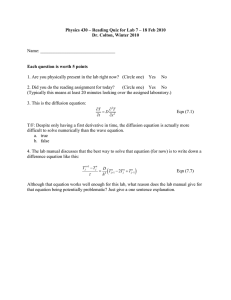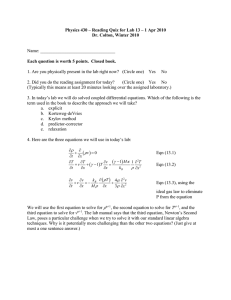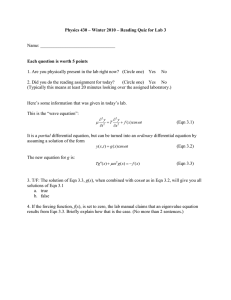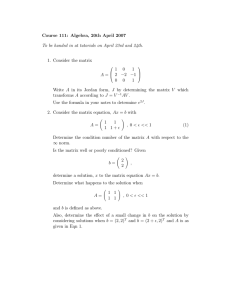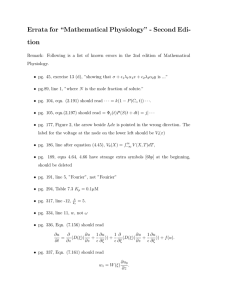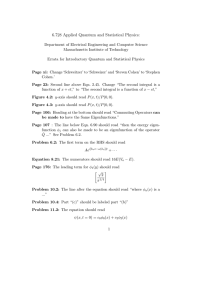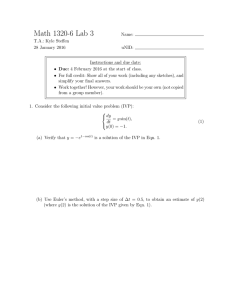Notes 9
advertisement
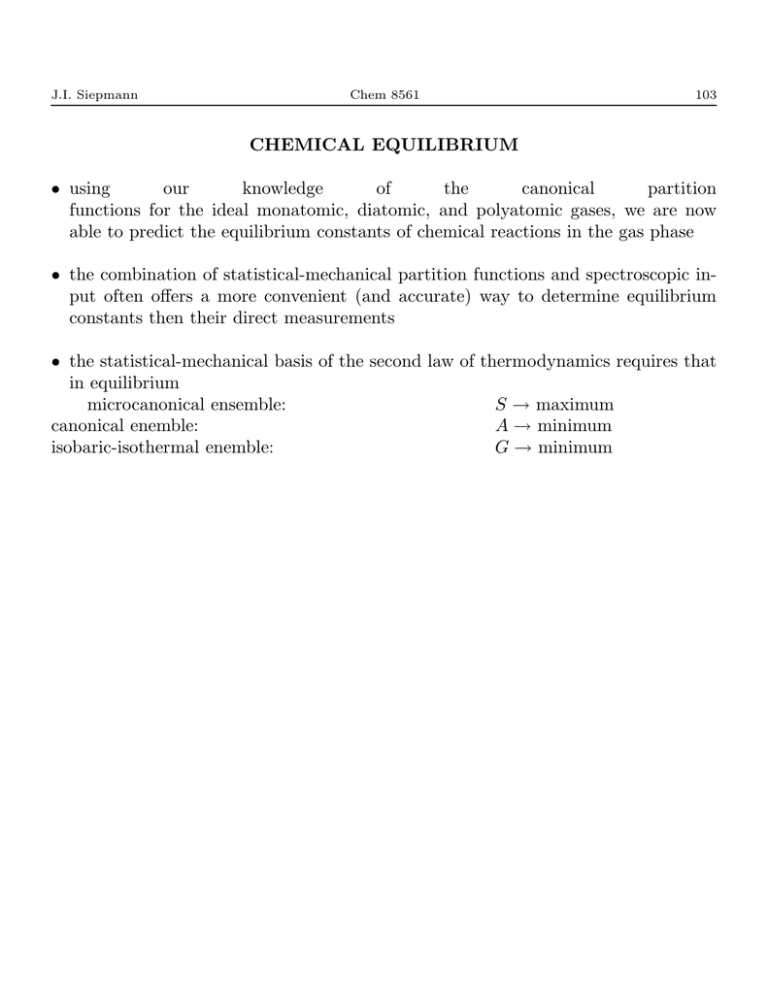
J.I. Siepmann Chem 8561 103 CHEMICAL EQUILIBRIUM • using our knowledge of the canonical partition functions for the ideal monatomic, diatomic, and polyatomic gases, we are now able to predict the equilibrium constants of chemical reactions in the gas phase • the combination of statistical-mechanical partition functions and spectroscopic input often offers a more convenient (and accurate) way to determine equilibrium constants then their direct measurements • the statistical-mechanical basis of the second law of thermodynamics requires that in equilibrium microcanonical ensemble: S → maximum canonical enemble: A → minimum isobaric-isothermal enemble: G → minimum J.I. Siepmann Chem 8561 104 • in an arbitrary multicomponent system of different species A, B, . . . we can solely focus on only the species which are involved in the chemical reaction, consider as an example the following homogeneous gas phase reaction νA A + νB B ⇀ ↽ νC C + νD D (205) which can be transformed into a more convenient mathematical form νC C + νD D − νA A − νB B = 0 (206) • considering a reaction vessel at fixed volume and temperature, the Helmholtz free energy is (see eqn. 29) dA = −S dT − p dV + X µi dNi i = X i µi dNi (207) J.I. Siepmann Chem 8561 105 • now define a variable λ (extent of reaction), such that dNi = vi′ dλ where vi′ = νi for products and vi′ = −νi for reactants dA = X i vi′ µi ! dλ (208) • since eqn. 208 has to be zero (second law) irrespective of the value of dλ, we conclude X vi′ µi = νC µC + νD µD − νA µA − νB µB = 0 (209) i • this result is a general thermodynamic fact and is valid for all kinds of chemical processes (i.e. it is not restricted to ideal gas mixtures) J.I. Siepmann Chem 8561 106 • eqn. 209 can also be derived using the isobaric-isothermal ensemble and the following approach • the Gibbs free energy of our chemical system (see eqn. 205) is G = NA µA + NB µB + NC µC + ND µD + . . . (210) • at equilibrium infinitesimal amounts νA dλ of A and νB dλ of B will react to form νC dλ of C and νD dλ of D; under the assumption that during this infinitesimal process the intensive variable like the chemical potentials of the individual species will remain constant, the change in Gibbs free energy is dG = (νC µC + νD µD − νA µA − νB µB ) dλ = 0 (211) • since dλ is arbitrary, the term in brackets must be equal to 0 and we again obtain eqn. 209 J.I. Siepmann Chem 8561 107 • in case our chemical system is a mixture of ideal gases, i.e. the different species are independent of each other, but distinguishable, the canonical partition function of the entire system is D Y qi (V, T )Ni Q(NA , NB , NC , ND , V, T ) = Ni ! (212) i=A • thus using eqn. 33 the chemical potential of each species is given by µi = −kB T = −kB T ln ∂ ln Q ∂Ni T,V,Nj6=i qi (V, T ) Ni (213) • by substitution of eqn. 213 into eqn. 209, and subsequent multiplication by −kB T , we obtain qD qA qB qC + νD ln = νA ln + νB ln (214) νC ln NC ND NA NB taking the exponentials and regrouping, we get NC νC ND νD qC νC qD νD = NA νA NB νB qA νA qB νB (215) J.I. Siepmann Chem 8561 108 • recognizing that q/V is a function of temperature only (see definition of the molecular translational partition function), we can define the equilibrium constant Kc of the reaction as follows (qC /V )νC (qD /V )νD ρ C νC ρ D νD = Kc (T ) = ρ A νA ρ B νB (qA /V )νA (qB /V )νB (216) • the equilibrium constant can also be expressed in terms of partial pressures instead of densities using the relation pi = ρi kB T pC νC pD νD pA νA pB νB = (kB T )νC +νD −νA −νB Kc (T ) Kp (T ) = (217) (218) J.I. Siepmann Chem 8561 109 • eqn. 215 can also be derived from purely statisticalmechanical arguments (i.e. without the use of the thermodynamic eqns. 207 and 210) • consider the simpler reaction A⇀ ↽ 2B (219) with the corresponding partition function qA NA qB NB Q(NA , NB , V, T ) = NA ! NB ! (220) • since the Helmholtz free energy is the characteristic function of the canonical ensemble, we can determine the minimum in A by finding the maximum in Q (or ln Q) using the constraint N = 2NA + NB (221) which follows from eqn. 219 and the fact that the total amount of material (mass) in the system remains constant J.I. Siepmann Chem 8561 110 • using the constraint, the NB ’s can be eliminated from eqn. 220 ln Q =NA ln qA + (N − 2NA ) ln qB − NA ln NA − (N − 2NA ) ln(N − 2NA ) + N − NA (222) and the maximum in Q can be determined from its partial derivative ∂ ln Q ∂NA N,V,T qA (N − 2NA∗ )2 = 0 = ln qB 2 NA∗ (223) and by resubstituting NB we obtain the equivalent of eqn. 215 for the binary reaction considered here (NB∗ )2 qB 2 (224) = NA∗ qA
